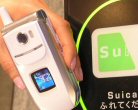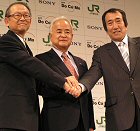NEC to Launch New Mobile Phones in Russia
NEC Corporation today announced its new step to expand global mobile business, the entry into mobile solution business in Russia. NEC revealed new mobile phones “e242” and “e101” to Russia. NEC also reveals its new branding strategy and slogan “Get Personal”, which is in line with NEC’s global corporate statement “Empowered by Innovation ( TM )”, to further expand its mobile business in Russia. Starting with these two new models with three color variation as one of the key products, NEC will pursue its new strategy to enter into the wider-range product market segment to appeal to various consumers in Russia. With the new and specific target market segmentation, NEC will further launch products answering to the requirements from every customer of each segment.


 In today’s program, we speak with Yutaka Nakamae from Panasonic’s Corporate External Relations Group who met with us during last fall’s CEATEC consumer electronics show in Tokyo. While there’s plenty of eye candy, including Panny’s 900iV (released in mid-2004), some skin-able models to please those who can’t decide on their favorite color and the very cool GSM X700 (now on sale in Europe), the real intelligence relates to finding our who’s boss in the carrier/manufacturer relationship (Hint: Who owns the customer?). Today’s proggy is not only a fun one — showing some great cellys from the October CEATEC show — but it also reconfirms the reality of the relationship between cell-phone makers and cellular operators in Japan — in this case, Panasonic and DoCoMo.
In today’s program, we speak with Yutaka Nakamae from Panasonic’s Corporate External Relations Group who met with us during last fall’s CEATEC consumer electronics show in Tokyo. While there’s plenty of eye candy, including Panny’s 900iV (released in mid-2004), some skin-able models to please those who can’t decide on their favorite color and the very cool GSM X700 (now on sale in Europe), the real intelligence relates to finding our who’s boss in the carrier/manufacturer relationship (Hint: Who owns the customer?). Today’s proggy is not only a fun one — showing some great cellys from the October CEATEC show — but it also reconfirms the reality of the relationship between cell-phone makers and cellular operators in Japan — in this case, Panasonic and DoCoMo. Mass transit meets mobile technology for Tokyo commuters in a new service enabling NTT DoCoMo FeliCa-equipped i-mode cell phones to function as Suica JR train commuter cards. The new service will combine DoCoMo’s FeliCa smart card e-money platform with the Suica IC train commuter card (both using technology developed by Sony) into one mobile handset that can simultaneously pay for train tickets, commuter passes, airline and movie tickets and purchases at any of 14,000 — and counting — retailers.
Mass transit meets mobile technology for Tokyo commuters in a new service enabling NTT DoCoMo FeliCa-equipped i-mode cell phones to function as Suica JR train commuter cards. The new service will combine DoCoMo’s FeliCa smart card e-money platform with the Suica IC train commuter card (both using technology developed by Sony) into one mobile handset that can simultaneously pay for train tickets, commuter passes, airline and movie tickets and purchases at any of 14,000 — and counting — retailers. East Japan Railway Company (JR East), NTT DoCoMo and Sony today announced they will offer a new service combining DoCoMo’s Mobile FeliCa smart-card handset with JR East’s Suica card starting in January 2006. The “Mobile Suica” service will enable FeliCa-enabled i-mode handsets to be used as Suica cards to board JR trains and make purchases in station shops and kiosks. With the news, two services that started as competitors for ecash settlement-on-the-go appear to have buried the yamakatana. Train-riding, phone-using consumers will have little excuse not to use FeliCa now. The companies said a test of the service will begin March 2005 using pilot i-mode FeliCa handsets.
East Japan Railway Company (JR East), NTT DoCoMo and Sony today announced they will offer a new service combining DoCoMo’s Mobile FeliCa smart-card handset with JR East’s Suica card starting in January 2006. The “Mobile Suica” service will enable FeliCa-enabled i-mode handsets to be used as Suica cards to board JR trains and make purchases in station shops and kiosks. With the news, two services that started as competitors for ecash settlement-on-the-go appear to have buried the yamakatana. Train-riding, phone-using consumers will have little excuse not to use FeliCa now. The companies said a test of the service will begin March 2005 using pilot i-mode FeliCa handsets.